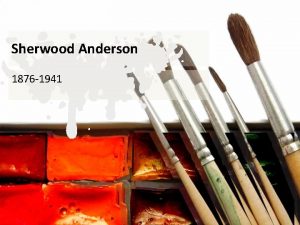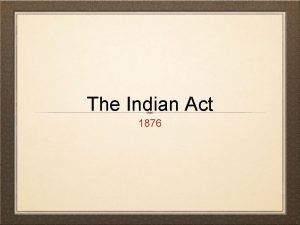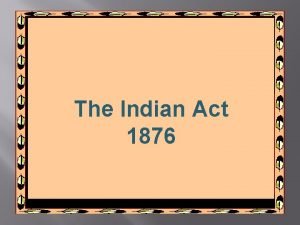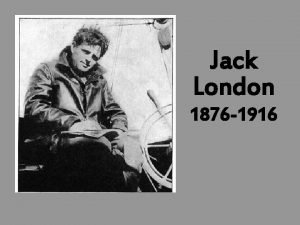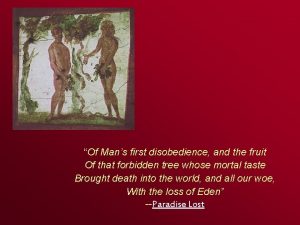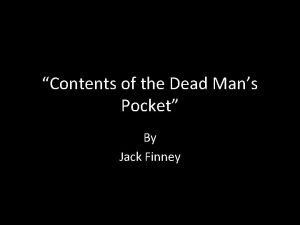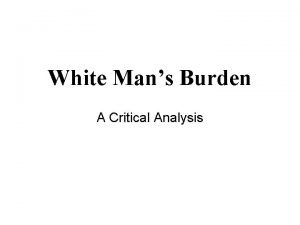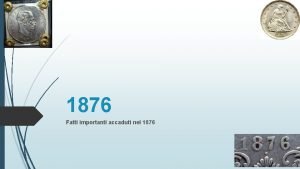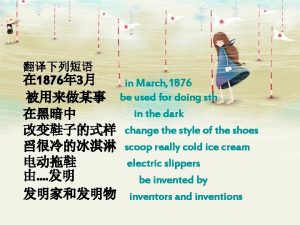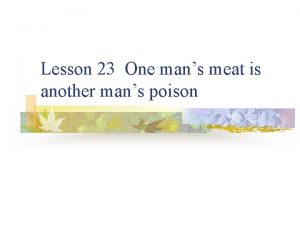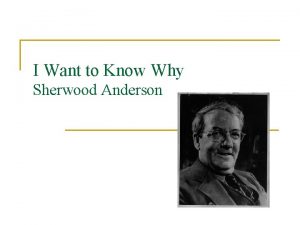Sherwood Anderson 1876 1941 The young mans mind




















- Slides: 20

Sherwood Anderson (1876 -1941) "The young man's mind was carried away by his growing passion for dreams. One looking at him would not have thought him particularly sharp. With the recollection of little things occupying his mind he closed his eyes and leaned back in the car seat. He stayed that way for a long time and when he aroused himself and again looked out of the car window the town of Winesburg had disappeared and his life there had become but a background on which to paint his dreams of his manhood. " (from Winesburg, Ohio)

Winesburg, Ohio http: //www. bartleby. com/156/ This collection of short stories allows us to enter the alternately complex, lonely, joyful, and strange lives of the inhabitants of the small town of Winesburg, Ohio.

Life http: //www. kirjasto. sci. fi/shanders. htm • • Writer whose prose style, derived from everyday speech, influenced American short story writing between World Wars I and II. Anderson made his name as a leading naturalistic writer with his masterwork, WINESBURG, OHIO (1919), a picture of life in a typical small Midwestern town, as seen through the eyes of its inhabitants.

Life http: //www. kirjasto. sci. fi/shanders. htm • • Anderson's episodic bildungsroman has been compared often to Edgar Lee Masters' Spoon River Anthology. cf http: //www. kirjasto. sci. fi/emasters. htm Bildungsroman: (German, from Bildung education + Roman novel. ) A novel dealing with one person's formative years or spiritual education.

Edgar Lee Masters (1869 -1950) • Life all around me here in the village: Tragedy, comedy, valor and truth, Courage, constancy, heroism, failure All in the loom, and oh what patterns! 'Petit, the Poet, ' from Spoon River Anthology

Sherwood Anderson: Early Life • • • Sherwood Anderson was born in Camden, Ohio. His parents led a transient life, moving from one place to another after work. His father had served in the Union Army and declined from the saddlery-and-harness business into odd jobs of house- and signpainting. Anderson attended school only intermittently, while helping to support his family by working as a newsboy, housepainter, stock handler, and stable groom. At the age of 17 he moved to Chicago where he worked as a warehouse laborer and attended business classes at night. During the Spanish-American war Anderson fought in Cuba and returned after the war to Ohio, for a final year of schooling at Wittenberg College, Springfield.

Career/Chicago Group • • For the next few years Anderson moved restlessly around Ohio. His life calmed down for some time with marriage and with work as a paint manufacturer. After suffering an emotional crisis - more or less orchestrated by Anderson himself - because of the conflicting demands of his family, business and creative life, he left his wife, 'bourgeois lifestyle', and moved to Chicago. There he took again a job in advertising and joined the so-called Chicago Group, which included such writers as Theodore Dreiser and Carl Sandburg.

WINDY MCPHERSON'S SON (1916), MARCHING MEN (1917), and Winesburg, Ohio (1919) • • Anderson's two first novels both containing the psychological themes of inner lives of Midwestern villages, the pursuit of success and disillusionment. His third novel, Winesburg, Ohio, was "half individual tales, half long novel form", as the author himself described it.

WINDY MCPHERSON'S SON (1916), MARCHING MEN (1917), and Winesburg, Ohio (1919) • • • It consisted of twenty-three thematically related sketches and stories. (Episodic sketches) Written in a simple, realistic language illuminated by a muted lyricism, Anderson dramatized crucial episodes in the lives of his characters. The narrative is united by the appearance of George Willard, a young reporter, who is in revolt against the narrowness of the small-town life and who acts as a counterpoint to the other people of the town.

WINDY MCPHERSON'S SON (1916), MARCHING MEN (1917), and Winesburg, Ohio (1919) • • The individual tales of Winesburg, Ohio, and Anderson's other collections of short stories, THE TRIUMPHS OF THE EGG (1921), HORSES AND MEN (1932), and DEATH IN THE WOODS (1933), directed the American short story away from the neatly plotted tales of O. Henry and his imitators. The stories in these books are characterized by a casual development, complexity of motivation, and an interest in psychological process.

The First Dial Award • • • In 1921 Anderson received the first Dial Award for his contribution to American literature. He travelled widely in Europe - in Paris he met Gertrude Stein, whose work he much admired. "She is an American woman of the old sort, one who cares for the handmade goodies and who scorns the factory-made foods, and in her own great kitchen she is making something with her materials, something sweet to the tongue and fragrant to the nostrils. "

Back to the States • • • After he returned back to the United States, he settled in New Orleans, where he shared an apartment with William Faulkner. He wrote, among others, the novel DARK LAUGHTER (1925), which became a bestseller. In the story the disillusioned protagonist travels down the Missisippi imagining the kind of book Mark Twain might now write.

New York - Europe • • From New Orleans Anderson moved to New York for some time, and from there finally to Marion, Virginia, where he built a country house, and worked as a farmer and journalist. He travelled again in Europe and wrote to his son John, a young painter: "I've a notion that, in America, you will be less bothered with homosexuality inclined men. However the arts have always been a refuge for such men. They are, as I think you have guessed, the less vigorous men. There is some distinct challenge of life they do not want to meet, and can't meet. "

Newspaper pieces • • In 1927 he bought both of Marion's weekly newspapers, one Republican, one Democrat, and edited them for two years. To earn extra income he continued his series of lectures throughout the country. Commissioned by Today magazine, Anderson studied the labor conditions during the Depression and collected his articles in PUZZLED AMERICA (1935). Anderson's newspaper pieces were collected in HELLO TOWNS (1929), RETURN TO WINESBURG (1967) and THE BUCK FEVER PAPERS (1971).

Later life • • Anderson's best works influenced almost every important American writer of the next generation. He also encouraged William Faulkner and Ernest Hemingway in their writing aspirations. Anderson died of peritonitis on an unofficial goodwill tour to South America, at Christobal, Canal Zone, on March 8, in 1941. After his death, Anderson's reputation soon declined, but in the 1970 s, scholars and critics have found a new interest in his work.

autobiographical • • During his lifetime Anderson wrote two autobiographical works, A STORY-TELLER'S STORY (1924) and semifictional TAR: A MIDWEST CHILDHOOD (1926). His MEMOIRS (1942) and LETTERS (1953) were published posthumously, as the more definitive THE MEMOIRS OF SHERWOOD ANDERSON (1969).

Autobiography vs. fiction • In A Story-Teller Story the author explained why he disregarded dates in his autobiographies: "I think it was Joseph Conrad who said that a writer only began to live after he began to write. It pleased me to think I was after all but ten years old. Plenty of time ahead for such a one. Time to look about, plenty of time to look about. "

Anderson’s Influence • • He wrote many tales depicting small-town life in the Midwest and had his first great success with Winesburg, Ohio (1916), an important work of experimental fiction set in a small-town environment. Anderson wrote simple, direct sentences, transferred his point-of-view to outside observers, and portrayed a slice of life rather than the large panorama of an epic tale; many subsequent writers, such as Hemingway and Faulkner, were influenced by his style. #

Winesburg, Ohio

• • • http: //andersonproject. winesburg. com/hisworks. ht m The Sherwood Anderson Review http: //oncampus. richmond. edu/academics/journali sm/01 summer. html
 One mans ceiling is another mans floor
One mans ceiling is another mans floor The egg sherwood anderson summary
The egg sherwood anderson summary 1876 ko uztailaren 21eko legea iruzkina
1876 ko uztailaren 21eko legea iruzkina Slidetodoc.com
Slidetodoc.com Dewey decimal system was introduced
Dewey decimal system was introduced Indian act 1876
Indian act 1876 Electronic age lcd projector
Electronic age lcd projector Texas constitution of 1876
Texas constitution of 1876 Jack london (1876-1916)
Jack london (1876-1916) Non-charitable trusts
Non-charitable trusts Man's first disobedience in paradise lost
Man's first disobedience in paradise lost Perspectives le mans
Perspectives le mans Mearns castle high school staff
Mearns castle high school staff Vase corinthien orné de musiciens 510 avant jc
Vase corinthien orné de musiciens 510 avant jc External conflict in contents of the dead man's pocket
External conflict in contents of the dead man's pocket Sherwood parkdale
Sherwood parkdale Släktföreningen svinhufvud
Släktföreningen svinhufvud Rivers passing through sherwood forest
Rivers passing through sherwood forest Sherwood parkdale skating club
Sherwood parkdale skating club White mans burden analysis
White mans burden analysis Frases fetes espinal
Frases fetes espinal

